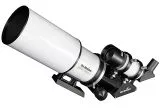- Details
Produktbeschreibung
Flecken / Artefakt / Beschlag auf ZWO ASI2600MC und MM Astro-Kameras
Dieser Bericht ist nur noch zur Information. Die Ursache wurde gefunden und das Problem vollständig gelöst.
Wie uns Kunden berichten läuft auf den Sensor Silikonöl aus. Dieses dürfte aus der Kühlpaste stammen, die den Sensor mit dem Kühlkörper verbindet und für eine optimale Wärmeableitung sorgt. Zwo bietet zur Lösung eine Anleitung zur Reinigung an siehe link:
https://astronomy-imaging-camera.com/manuals/How_to_clean_ASI_camera_and_redry_the_desiccant.pdf?fbclid=IwAR1n7uHUOH74--CUmh6vuh6fVm6v44WR5QPJPn-pKgxHuTOPk-Vlu_3F7xI
Die Aufwärmphase ist jedoch wahrscheinlich das weitaus größere Problem. Wenn Sie mit hoher TEC-Leistung arbeiten (maximale Kühlung) und dann die Kamera einfach abschalten, ist die thermische Anstiegszeit sehr schnell, wenn es keine Softwarekontrolle gibt. Das TEC ist im Betrieb auf der einen Seite sehr, sehr heiß und auf der anderen Seite kalt. Außerdem ist er dünn - nur ein paar Millimeter dick. Wenn der Strom einfach abgeschaltet wird, gleicht der TEC dies aus, indem er die Wärme sofort an die kalte Seite des TEC-Geräts abgibt. In solchen Fällen kann das sehr kalte Pad sehr schnell auf einer Seite erwärmt werden.
UPDATE 22.11.2021
In der Zwischenzeit hat sich herausgstellt, dass auch bei Lagerung der Kamera dieser Effekt auftreten kann.
Einer unserer Kunden hat sich auch mit dem Thema beschäftigt und uns folgende Informationen zukommen lassen:
Das im Wärmetransferpad enthaltene Silikon kann ausgasen. Es verdampfen Siloxane mit niedrigem Molekulargewicht (LMWS); handelsübliche Siliconelastomere enthalten bis zu 5 % niedermolekulare Siloxanreste. Eine Quelle für niedermolekulare Siloxane sind verstärkende und streckende Füllstoffe, die zur Erhöhung der Festigkeit und zur Veränderung bestimmter physikalischer Eigenschaften des Endprodukts verwendet werden.
[Quelle: http://sinoguide.com/event/brief-illumination-of-the-silicone-outgassing-from-sinoguide-technology/]
Bei normalen Umgebungsbedingungen kann es dennoch zu Ölaustritt während der Lagerung kommen, was bei thermischen Bealstungen noch verstärkt wird. In einigen optischen Instrumenten verdampft Siloxan und kondensiert als Ölflüssigkeit auf dem Sensor.
[Quelle: http://sinoguide.com/event/lowest-oil-leaking-thermal-gap-pad/]
Wir sind mit einer Lösungsfindung berschäftigt und werden hier den aktuellen Stand posten.
Euer Karsten
Diesen Artikel haben wir am 26.10.2021 in unseren Katalog aufgenommen.
Profitieren Sie von unseren Erfahrungen als Teleskop-Spezialisten:
denn sehen heißt verstehen
in besonderen Fällen auch Vor-Ort-Service im Raum München


